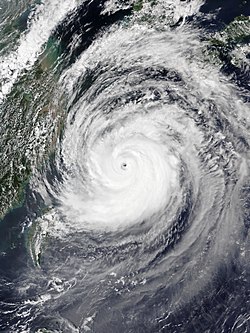 Maysak near peak intensity over the Ryukyu Islands on September 1 | |
| Meteorological history | |
|---|---|
| Formed | August 27,2020 |
| Extratropical | September 3,2020 |
| Dissipated | September 7,2020 |
| Very strong typhoon | |
| 10-minute sustained (JMA) | |
| Highest winds | 175 km/h (110 mph) |
| Lowest pressure | 935 hPa (mbar);27.61 inHg |
| Category 4-equivalent typhoon | |
| 1-minute sustained (SSHWS/JTWC) | |
| Highest winds | 220 km/h (140 mph) |
| Lowest pressure | 930 hPa (mbar);27.46 inHg |
| Overall effects | |
| Fatalities | 46 total |
| Damage | $100 million (2020 USD) |
| Areas affected | Philippines,Korean Peninsula,Japan,Northeast China,Russian Far East |
| IBTrACS | |
Part of the 2020 Pacific typhoon season | |
Typhoon Maysak,known in the Philippines as Typhoon Julian,was a deadly,damaging and powerful tropical cyclone that struck the Ryukyu Islands and the Korean Peninsula in early September 2020. The third typhoon of the 2020 Pacific typhoon season,Maysak formed from a tropical disturbance. The disturbance gradually organized,receiving the name Julian from PAGASA as it became a tropical depression. As the depression strengthened,the JMA subsequently named the system Maysak. Maysak rapidly intensified into a strong typhoon before weakening and making landfall in South Korea.
Contents
- Meteorological history
- Preparations and impact
- Japan
- South Korea
- North Korea
- China
- Russia
- See also
- References
- External links
Maysak was the second of three typhoons to affect the Korean Peninsula within two weeks,the others being Bavi and Haishen. It was also responsible for the loss of a livestock carrier Gulf Livestock 1,that sank 100 nautical miles West off from Amami Ōshima,Japan on September 2,2020,taking 41 out of the 43 crew members on board.

